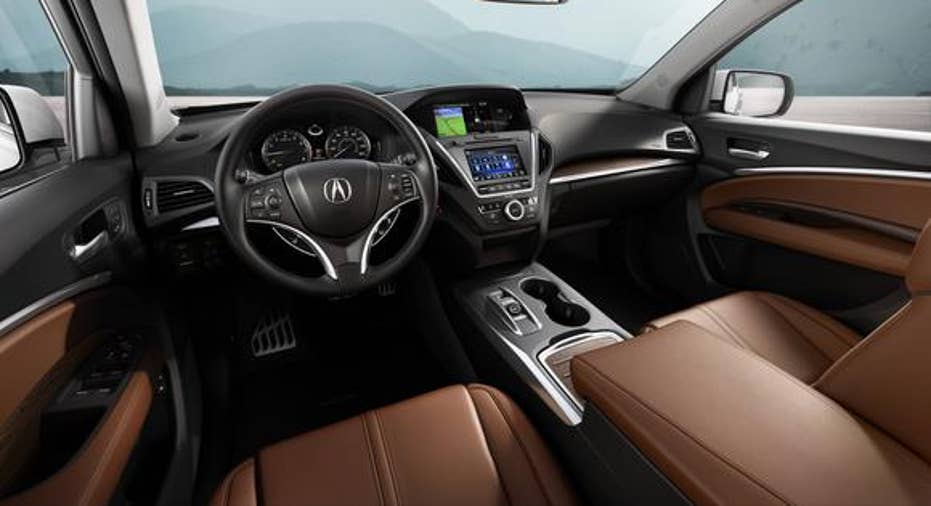How Honda's Latest SUV Takes a Big Step Toward Self-Driving Cars

The Acura MDX gets a facelift for 2017. It also gets some new standard features, including a suite of "assisted driving" systems. Image source: Honda.
Honda took the wraps off of its updated 2017 Acura MDX in New York last week. The revamped version of MDX, a "three row" crossover SUV, gets a new nose, a new hybrid version, and a bunch of new technology.
The latter includes this interesting move: Honda will make its latest package of assisted-driving technologies standard on all versions of the MDX starting with the 2017 model.
That may not sound like a big deal. But with this move, Honda is moving one more step closer to a self-driving future. Here's why.
Standard features that aren't far from a limited self-driving packageThat package of assisted-driving technologies is called AcuraWatch. It builds on the AcuraWatch Plus package that has been a $1,500 option on the MDX.
Of course, it isn't quite a self-driving package like Mercedes-Benz's Drive Pilot or Tesla Motors' Autopilot, which allow for limited hands-free driving on highways under certain conditions. But if you haven't bought a new car recently, you might be surprised by just how much automated "assistance" you can get in an SUV that will start around $44,000.
All of these features use radar, an onboard camera, or both. Here's the list.
- Collision Mitigation Braking System: Uses a forward-facing radar system to scan for objects in front of the car. If it thinks a collision is possible, it signals the driver to brake. If a collision is imminent, it automatically tightens the seatbelts and -- again, automatically -- slams on the brakes for you. The driver can adjust the system's sensitivity, but it's always on.
- Lane Departure Warning: A camera mounted between the windshield and rearview mirror detects the lane markings painted on highways. If it senses that the car is unintentionally drifting out of its lane, it beeps and warns the driver. Works when the car is traveling at highway speeds (between 45 and 90 miles per hour). Can be switched on and off by the driver.
- Forward Collision Warning: Uses the camera to scan for objects in front of the car. If the car is moving faster than 10 miles per hour and the system thinks a collision is possible, it beeps and flashes a warning light. Can be switched on and off by the driver.
- Lane Keeping Assist: If the Lane Departure Warning system detects that the car is wandering out of its lane on the highway, this system automatically vibrates the steering wheel (to alert the driver) and, if the driver doesn't correct course, the system will automatically steer the car back into its lane. Works when the car is traveling at highway speeds, can be switched on and off by the driver.
- Adaptive Cruise Control with Low Speed Follow: A cruise control system that uses radar to keep the car at a pre-set distance behind the car in front of it. If the vehicle in front slows down or stops, the system alerts the driver and, if necessary, applies the brakes. Can be switched on and off by the driver.
- Road Departure Mitigation: Another system that will automatically apply brakes and steering corrections if it detects that the car is about to wander out of its lane at highway speeds. Unlike the Lane Keeping Assist system, this system automatically intervenes without warning the driver first. Can be switched on and off.
Does all of that add up to self-driving? Not quite, and Honda doesn't claim that it might. And if you've been shopping for similar vehicles recently, those features probably sound ho-hum. But taken together, the new MDX's functions aren't too far behind the Tesla and Mercedes-Benz systems.
I think that's a big deal.
So why is this important?Simply put, it's because each of these systems is a building block of the self-driving cars of the near future -- and they're all now standard equipment on an SUV that starts at $44,000, and available on models that cost even less.
"It's a very big statement on where the technology is going and how democratized it's becoming," said Eric Lyman, vice president of strategic insights at TrueCar. Lyman notes that the AcuraWatch system was originally only available on the top-of-the-line version of the MDX. Starting later this year when the 2017 models begin arriving at dealers, it will be standard on all of them.
The 2017 Acura MDX gets a revamped interior, too. Image source: Honda.
Even within Honda's suite of products, these features are already moving further downmarket. They're all available on Honda's compact CR-V and midsize Pilot SUVs, too. For now, the Honda-brand SUVs only offer the package on higher-level trims. But still: For a little over $32,000, you can buy a top-of-the-line CR-V Touring that includes all of these same features. And most of Honda's rivals now offer similar packages.
Long story short: Self-driving cars might still seem futuristic. But even mass-market cars are now available with features that, taken together, get awfully close to limited self-driving functionality. The future is getting a lot closer.
The article How Honda's Latest SUV Takes a Big Step Toward Self-Driving Cars originally appeared on Fool.com.
John Rosevear has no position in any stocks mentioned. The Motley Fool owns shares of and recommends Tesla Motors. Try any of our Foolish newsletter services free for 30 days. We Fools may not all hold the same opinions, but we all believe that considering a diverse range of insights makes us better investors. The Motley Fool has a disclosure policy.
Copyright 1995 - 2016 The Motley Fool, LLC. All rights reserved. The Motley Fool has a disclosure policy.



















